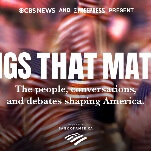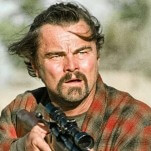Yet the pilot keeps bumping up against those Mad Men comparisons, which extend beyond the period setting or high-pressure business environment. The lead is Joe MacMillan, played by Lee Pace, but the character may as well be named “Tron Draper.” He’s a fast-talking, super-smooth salesman type who’s good at telling people what they want to hear and always thinking five or six steps ahead of the competition. He’s also got something of a way with the ladies and a troubled past. The one thing the character lacks that was a major part of the early Mad Men version of Don Draper is a tortured family life, which is given to MacMillan’s unlikely partner, Gordon Clark (Scoot McNairy), who comes complete with a wife, Donna (Kerry Bishé), who just keeps crushing his dreams. (The AMC Prestige-Drama-O-Matic 3000 captures even the less enjoyable elements of the formula.)
To say what MacMillan’s ultimate goal is would spoil some of the pilot’s finer moments. Suffice to say that everything hinges on his having an ace in the hole, who turns out to be Cameron Howe (Mackenzie Davis), a female coder who’s better than any of the guys in her college class but seems unlikely to get a shot at proving herself. It’s easy to see her as the Peggy to the Voltron Draper formed by Joe and Gordon (except that she has sex with one of them in the teaser), but in Davis’ hands, Cameron is the best thing about the pilot. Davis has a brash, almost screwball energy, and she has a tendency to barrel through scenes like everybody else had better get out of her way. She bounces particularly well off of Pace, who’s having the hammy time of his life, and it should be fun watching the three central characters’ energies shoot off in completely divergent directions. (The other series regular is the always fun Toby Huss, who is mostly given thankless material to play here but still manages to find interesting beats and line readings.)
There’s a lot to love in the Halt And Catch Fire pilot, but there’s an implicit warning sign in its network’s handling of the material. See, AMC sent out only the pilot to critics, incredibly unusual for a cable network. (AMC’s last drama debut, Turn, sent out three episodes.) This is more common for broadcast networks, where production schedules are much tighter, but cable shows are so dependent on getting time to build out their worlds that a lack of additional episodes sometimes indicates problems the network is aware of. It’s entirely possible that, say, Bishé’s character is given new depths in episodes two or three or four, but we can’t really know that now.
Yet even if the reasons for holding episodes back are understandable—a tight post-production process, say, or a desire to avoid possible twists leaking—there’s at least one glaring warning sign by the end of this pilot that should give just about anyone pause: By the time the episode reaches its end, it’s not immediately clear in the slightest what this show is even about. That wasn’t clear at the end of the Mad Men pilot either, but at least that episode suggested a world and a main character worth delving into, instead of a simulacrum of such things. Halt And Catch Fire has a great cast, a neat title, a solid pilot script from Chris Cantwell and Chris Rogers, and some intriguing direction from Juan José Campanella that turns both the human face and circuit boards into things to be broken down into component parts and understood. But it lacks a suggestion that it will reassemble the parts of better dramas that it has gathered into something uniquely its own, instead of a mostly functional knockoff.








































